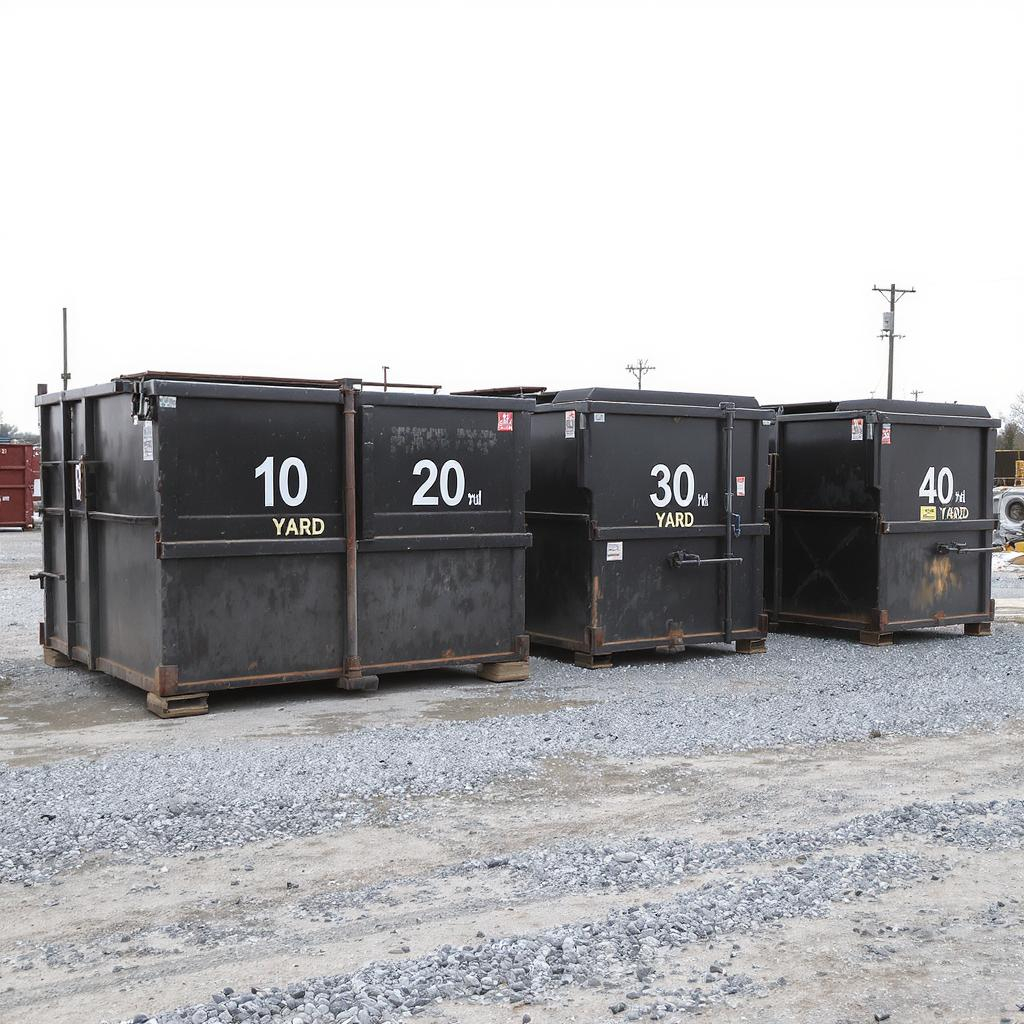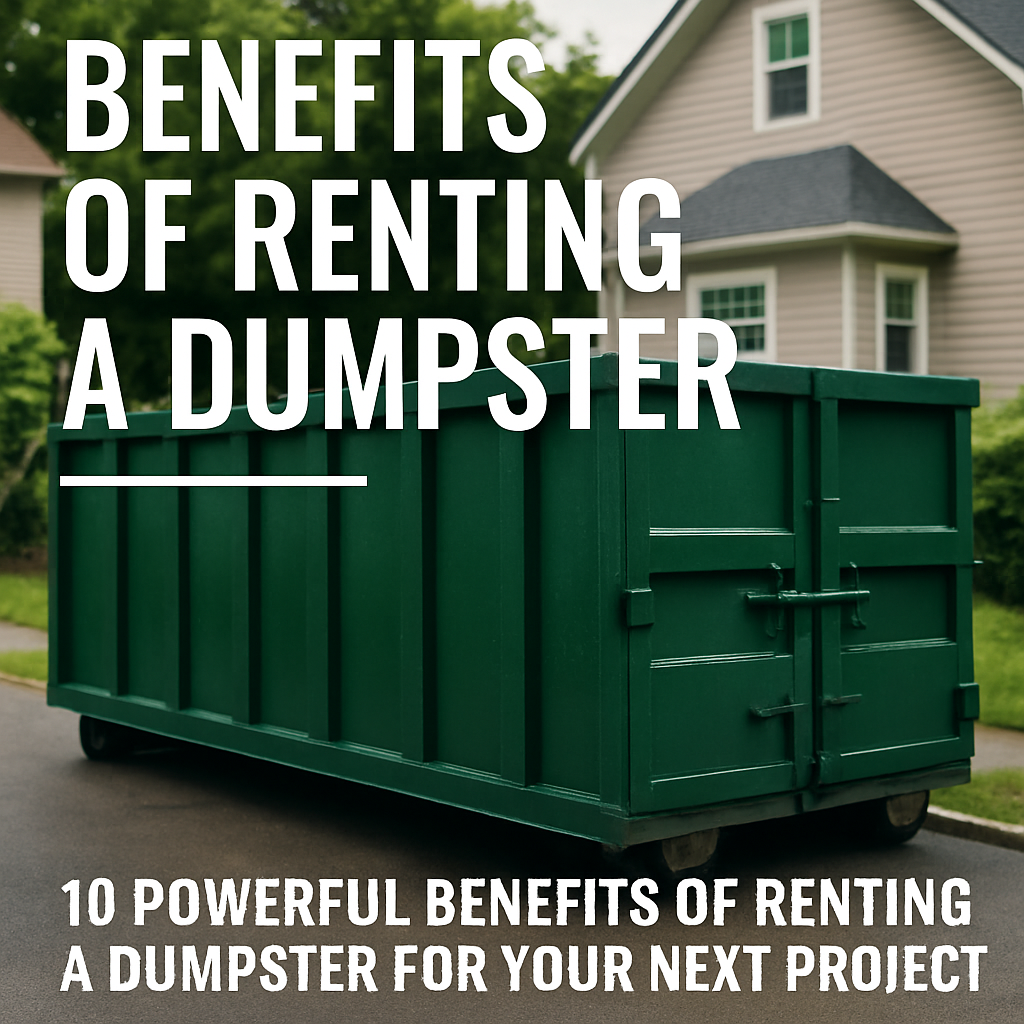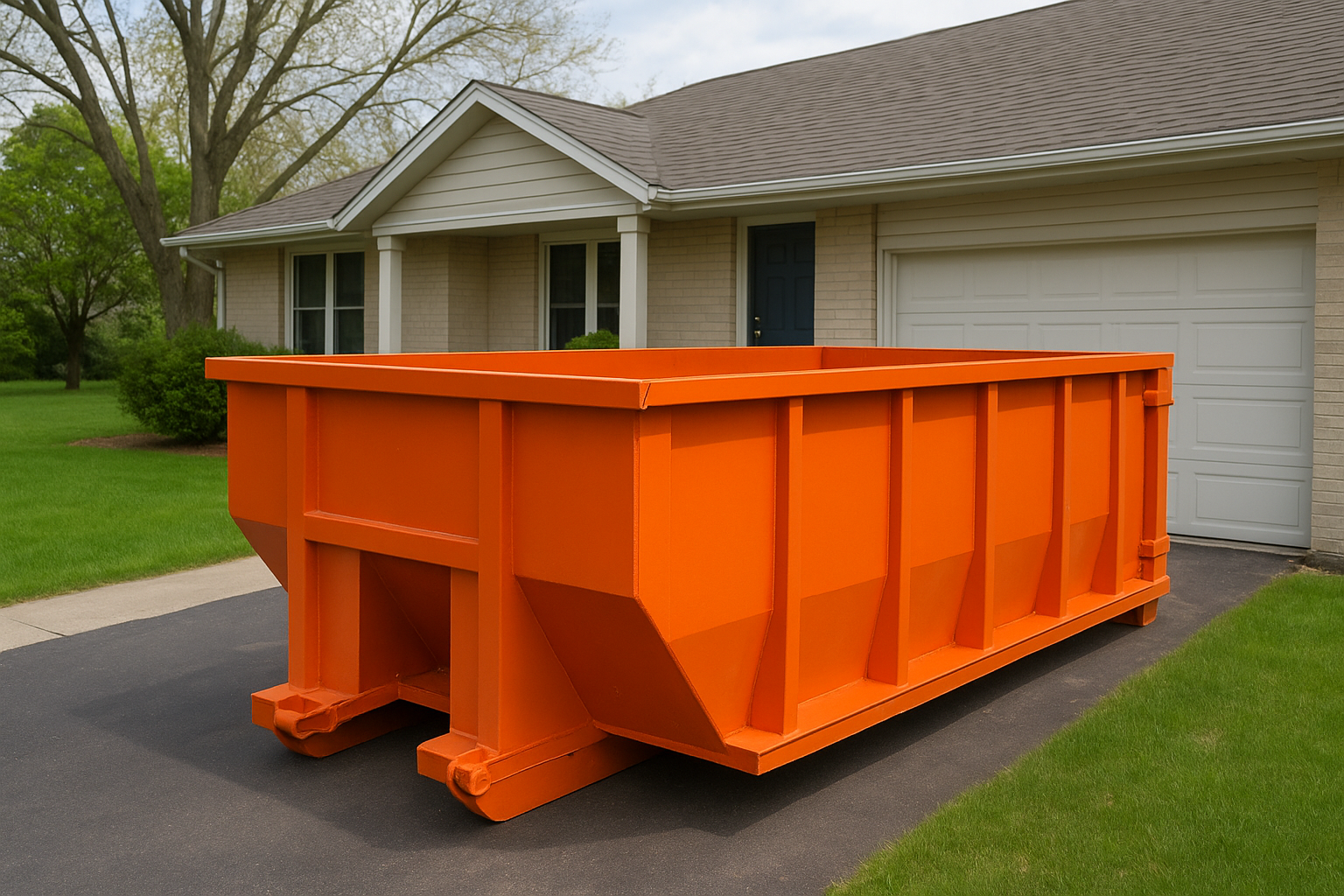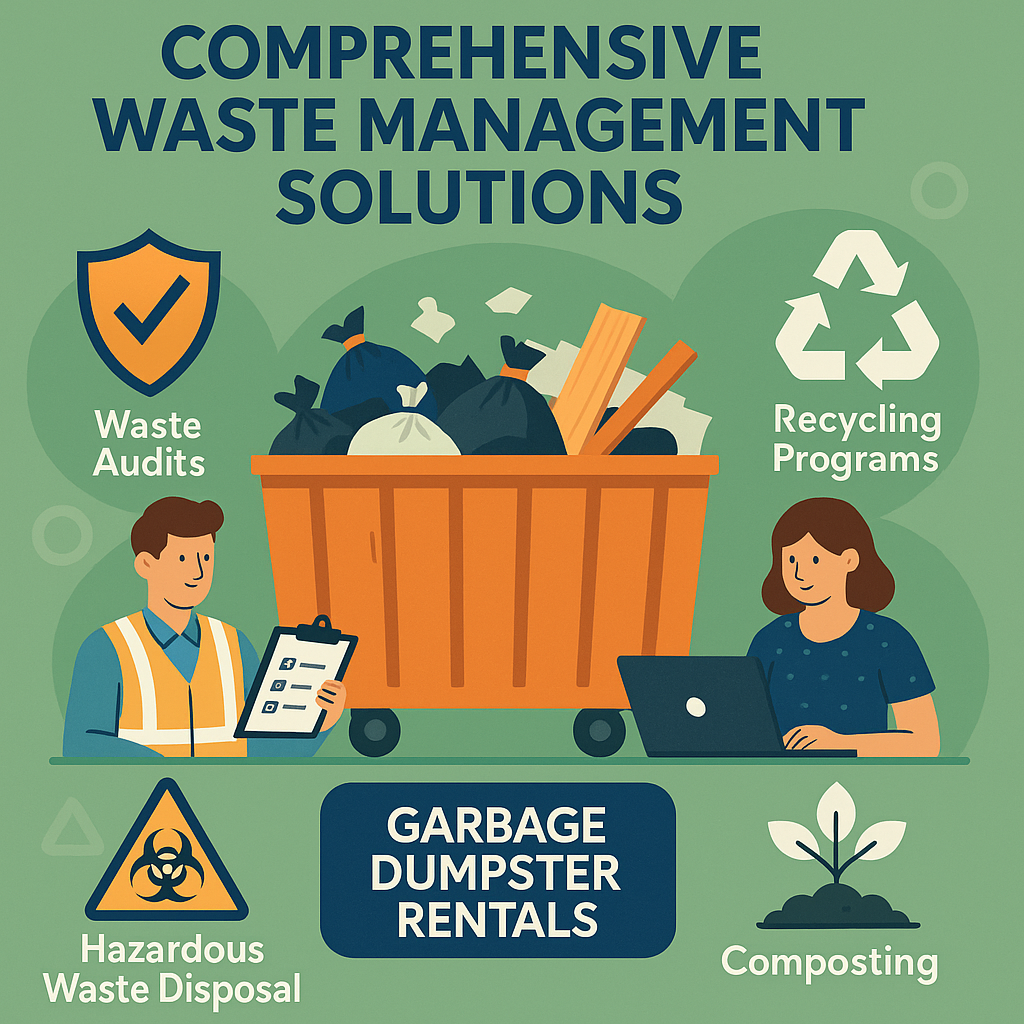
Introduction to Specialty Dumpsters
What Are Specialty Dumpsters?
Specialty dumpsters are custom-designed containers tailored to specific waste types like concrete, yard debris, roofing shingles, used wood, and recyclable materials. Unlike general-purpose containers, these are optimized for:
-
Material weight and volume
-
Disposal regulations
-
Safe transportation and efficient handling
They help streamline projects and improve recycling outcomes by ensuring each type of waste is collected properly.
Why Standard Dumpsters Aren’t Always Enough
A typical garbage dumpster rental might handle mixed debris—but mixing materials can cause:
-
Contamination of recyclable goods
-
Higher tipping fees
-
Safety issues due to overloading
Specialty dumpsters are the key to efficient waste management services, especially on complex job sites or sustainable building projects.
The Importance of Sizing in Waste Management
Using the wrong dumpster size results in:
-
Overflow and unscheduled hauls
-
Overweight charges
-
Wasted space and money
Proper sizing and selection of waste management dumpster rentals based on material density ensure smoother workflows and compliance with local disposal laws.
Understanding Waste Segregation and Its Importance
What Is Waste Segregation?
Waste segregation is the process of separating waste materials by type—wood, metal, concrete, recyclables—to enable proper processing, disposal, or reuse. On construction and demolition sites, it’s vital for:
-
Complying with environmental regulations
-
Supporting recycled wood products and other recycling streams
-
Reducing landfill impact
Benefits for Recycling and Safety
When properly segregated:
-
Materials can be reused or sold
-
Sites remain safer and cleaner
-
Risk of injury or fines is reduced
It also enables builders to achieve LEED or green building certification through responsible waste practices.
Environmental and Legal Implications
States like Florida encourage wood recycling and material diversion. Proper use of specialty dumpsters for recycled timber and debris:
-
Reduces greenhouse gas emissions
-
Minimizes illegal dumping
-
Fulfills state and federal reporting requirements
Types of Specialty Dumpsters and Their Uses
Concrete Dumpsters
-
Typically 10-yard or low-wall roll-offs
-
Built for heavy, dense material
-
Ideal for foundations, sidewalks, driveways
Roofing Material Dumpsters
-
Often 20-yard units
-
Designed for shingles, tar paper, flashing
-
Lined to prevent leaks or residue buildup
Yard Waste Dumpsters
-
For branches, sod, mulch, and grass
-
Required for storm cleanup or landscaping
Mixed Construction Debris Dumpsters
-
Accept drywall, insulation, carpet, and small amounts of wood
-
Used during remodeling and demolition
Wood Recycling Dumpsters
-
Exclusively for used wood, pallets, reclaimed wood, framing lumber
-
Supports wood reclamation and local Florida wood recycling programs
Specialty Dumpsters for Recyclable Materials
Dumpsters for Metals and Cardboard
Metals and cardboard are highly recyclable but must be kept clean and dry. Separate dumpsters prevent contamination and ensure these materials reach appropriate facilities.
Dedicated Dumpsters for Recycled Wood Products
Contractors can use dedicated containers for:
-
Flooring
-
Plywood
-
Trim and framing scraps
This supports production of recycled wood products like MDF, mulch, or engineered beams.
Using Dumpsters for Florida Wood Recycling
In Florida, many facilities accept clean wood debris in:
-
20-yard dumpsters (for volume)
-
Labeled roll-offs for recycled lumber
Using the correct dumpsters helps avoid costly rejections and ensures material is processed properly.
Wood Waste: Choosing Dumpsters for Reclaimed and Recycled Timber
Identifying Used Wood on Site
Used wood includes:
-
Old framing
-
Demolition timber
-
Disassembled pallets
-
Cabinetry and trim
Sorting these items early speeds up removal and repurposing.
Sizing Dumpsters for Pallets and Framing Lumber
-
10-yard: Small carpentry jobs or furniture shops
-
20-yard: Most framing or demolition work
-
30–40-yard: Bulk lumber recovery from major projects
Correct sizing ensures space and avoids overweight penalties.
Efficient Lumber Repurposing with On-Site Containers
Having a labeled reclaimed wood bin on site encourages reuse. Workers can place clean lumber directly into it, keeping it separate from mixed debris. This increases recovery rates and reduces landfill trips.
How to Size a Dumpster Based on Waste Type
10-Yard vs 20-Yard vs 30-Yard vs 40-Yard
Choosing the right dumpster size depends on both volume and weight:
| Dumpster Size | Best For |
|---|---|
| 10-Yard | Concrete, bricks, soil, reclaimed wood |
| 20-Yard | Mixed construction debris, used wood, roofing |
| 30-Yard | Large demolition sites, drywall, lumber repurposing |
| 40-Yard | Light, bulky recyclables like insulation, cardboard |
Heavier materials like concrete or recycled timber are best handled in smaller dumpsters to avoid exceeding weight limits.
Weight Limits and Material Densities
Each dumpster has a legal weight limit based on transport regulations. For example:
-
A 10-yard concrete dumpster might hit weight capacity when half full
-
A 40-yard dumpster filled with drywall might weigh less than a 20-yard filled with wood
Waste dumpster rental services help calculate expected weights based on project type and debris mix.
Specialty Dumpsters for Lightweight Recyclables vs Heavy Debris
Separate dumpsters prevent lightweight recyclables (e.g., cardboard) from being compacted by heavier waste. This preserves their integrity for recycled wood products and fiberboard production.
Using Garbage Dumpster Rentals for Construction Waste
Pros and Cons of Standard Dumpsters
Garbage dumpster rentals are versatile but have limitations:
-
✅ Pros: Widely available, easy to rent, multi-use
-
❌ Cons: Risk of cross-contamination, unsuitable for dense debris, not ideal for wood recycling
When to Opt for Specialty Models
Use waste management dumpster rentals when:
-
You’re working with concrete, roofing, or recycled lumber{:rel=“nofollow noopener”}
-
You need to comply with diversion goals or regulations
-
You want to avoid costly overage and contamination fees
Avoiding Contamination and Overage Fees
-
Don’t mix treated wood with recyclable material
-
Keep food, plastic, or hazardous materials out of wood reclamation bins
-
Monitor loading regularly to prevent overweight fines
Waste Dumpster Rental Options for Different Industries
Construction and Demolition
These sites often require:
-
Concrete dumpsters
-
Reclaimed wood bins
-
General debris containers
Proper dumpster planning boosts safety and reduces disposal costs.
Landscaping and Tree Removal
Projects typically use:
-
Yard waste dumpsters
-
Mixed green waste containers
-
Specialty bins for branches and mulch
Many of these are composted or chipped for reuse.
Retail and Warehousing
High-volume cardboard and pallet waste is best managed with:
-
Dedicated recycled wood products dumpsters
-
Metal recycling containers
-
Compactors for packaging material
Renovation and Remodeling
Projects produce:
-
Flooring and cabinetry scrap
-
Drywall, insulation, and wood trim
Labeled dumpsters help capture salvageable used wood for lumber repurposing.
Waste Management Dumpster Rentals for Efficient Segregation
How Providers Label and Manage Waste Types
Reliable waste management services offer:
-
Clearly marked dumpsters (color-coded or labeled)
-
Educational signage for job sites
-
Guidelines for loading and restrictions
This encourages proper sorting and cleaner recycling streams.
Tools and Support Services
Top waste management companies also provide:
-
Weight tracking systems
-
On-site waste audits
-
LEED-compliant documentation for sustainable projects
Case Studies of Dumpster-Based Segregation
In Tampa, a construction site diverted 78% of debris using:
-
A wood-only dumpster for Florida wood recycling
-
A 10-yard container for concrete
-
A 20-yard bin for general waste
This approach saved $12,000 in landfill fees and earned LEED Silver certification.
Environmental Benefits of Specialty Dumpsters
Improving Recycling Rates
By separating waste at the source, specialty dumpsters:
-
Prevent contamination
-
Increase material recovery rates
-
Boost contribution to circular economy models
Reducing Landfill Overload
Avoiding landfill use reduces methane emissions and environmental damage. Recycled timber{:rel=“nofollow noopener”} and concrete can be reused indefinitely, decreasing demand for virgin resources.
Supporting Wood Reclamation and Circular Economy
Lumber that’s reclaimed and reused in recycled wood products:
-
Conserves forests
-
Reduces energy use in milling
-
Extends the lifecycle of valuable hardwoods
How to Arrange for Specialty Dumpster Rental
Choosing a Provider
Look for waste management dumpster rental companies that:
-
Offer specialty sizes
-
Provide support for wood reclamation{:rel=“nofollow noopener”} or recycling
-
Have strong reviews and transparent pricing
Scheduling and Permit Requirements
-
Check local zoning for placement regulations
-
Secure permits if placing dumpsters in public areas
-
Plan for regular pickups to avoid overflow
Pricing Based on Material and Weight
Dumpster rates vary depending on:
-
Dumpster size
-
Type of material (concrete vs. wood)
-
Rental duration
Specialty units may cost slightly more upfront, but save on avoided overage or contamination fees.
Best Practices for Specialty Dumpster Usage
Loading Techniques
Efficient loading can save money and prevent safety issues. Keep in mind:
-
Distribute weight evenly across the dumpster
-
Avoid overfilling—never load above the rim
-
Stack materials like reclaimed wood or panels flat to optimize space
Specialty dumpsters, especially those used for recycled timber or concrete, often have lower walls for easier loading.
Safety Guidelines
Whether you’re using a waste dumpster rental for construction debris or garbage dumpster rentals for general cleanup, follow these tips:
-
Wear gloves and safety gear when loading
-
Keep the area around the dumpster clear
-
Use caution with treated or hazardous materials
For wood, make sure to separate splintered, moldy, or chemically treated used wood from clean, salvageable material.
Communication with Waste Management Partners
Ensure your team:
-
Understands what each dumpster is for
-
Knows what materials are prohibited
-
Has a point of contact for questions
Top waste management services{:rel=“nofollow noopener”} often provide printed materials or signage to help on-site crews stay compliant and efficient.
Using Specialty Dumpsters for Wood Reuse and Recovery
Dedicated Dumpsters for Reclaimed Wood and Flooring
Dedicated bins allow teams to preserve high-quality lumber during demolition. Reclaimed wood from:
-
Flooring
-
Beams
-
Barn siding
…can be resold, donated, or repurposed.
Keep these bins covered to protect wood from rain or contamination.
Sorting Recycled Lumber from Demolition Sites
Segregating recycled lumber as it’s removed allows for:
-
Faster project cleanup
-
Higher resale value
-
Easier delivery to Florida wood recycling centers or reuse shops
Some sites even host on-site processing (e.g., de-nailing stations) to prep wood for resale immediately.
Partnering with Florida Wood Recycling Facilities
Many Florida wood recycling companies accept:
-
Clean framing lumber
-
Unpainted plywood
-
Pallets and crates
Establish a partnership with these facilities to reduce tipping fees and improve your sustainability profile.
Combining Dumpster Use with Sustainable Practices
Diverting Debris from Landfills
Combining specialty dumpsters with smart waste management:
-
Decreases environmental impact
-
Extends landfill lifespan
-
Reduces project carbon footprints
Construction sites can divert up to 80% of waste by simply sorting debris correctly.
Documentation for Green Building Certifications
For builders pursuing LEED, WELL, or Green Globes certifications:
-
Specialty dumpsters support the required diversion metrics
-
Recycled wood products help meet material sourcing guidelines
-
Detailed hauling records aid in certification paperwork
Tracking Recycled Wood Products by Volume
Some waste management companies{:rel=“nofollow noopener”} offer:
-
Waste tracking dashboards
-
Printable monthly reports
-
QR codes on dumpsters to trace loads by material type
This helps contractors prove environmental performance and meet ESG goals.
FAQs About Specialty Dumpsters and Waste Segregation
Q1: What size dumpster should I use for concrete?
A 10-yard dumpster is ideal for concrete due to weight restrictions. It’s low to the ground and designed for heavy materials.
Q2: Can I mix wood and drywall in a dumpster?
Not in specialty dumpsters. Mixing materials contaminates recyclables. Keep used wood, drywall, and metal in separate containers.
Q3: Are there dumpster options for wood reclamation?
Yes, many providers offer dedicated reclaimed wood dumpsters that allow for the reuse and resale of clean lumber.
Q4: Do I need separate dumpsters for recycling?
Yes, if your goal is waste diversion. Specialty dumpsters for recycled timber, metal, and cardboard are necessary to avoid contamination.
Q5: What happens to separated waste after collection?
It’s transported to appropriate facilities—concrete to crushers, recycled lumber to mills or salvage yards, and cardboard to fiber recovery plants.
Q6: How do I avoid overweight fees?
Know your material. Use small dumpsters for heavy debris like concrete and wood. Don’t exceed fill lines and confirm weight limits with your provider.
Conclusion: Choosing the Right Dumpster for Every Job
Specialty dumpsters are more than just bins—they’re tools that empower smarter, safer, and more sustainable waste practices.
✅ With the right planning, you can:
-
Save money by avoiding overage and contamination fees
-
Support the production of recycled wood products and other reclaimed materials
-
Improve project efficiency and earn green building certifications
Whether you’re managing a demolition site, a renovation, or a landscaping overhaul, there’s a specialty dumpster that fits your needs. Consider using dedicated containers for reclaimed wood, recycled timber, and other recyclable materials.
♻️ The next time you search for waste dumpster rental or garbage dumpster rentals, think beyond the standard—and go specialty.



